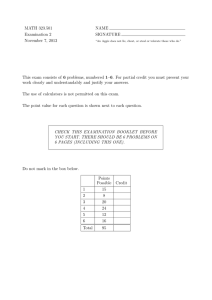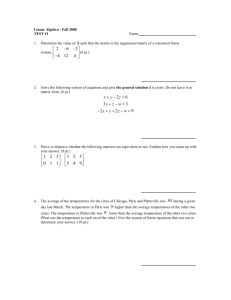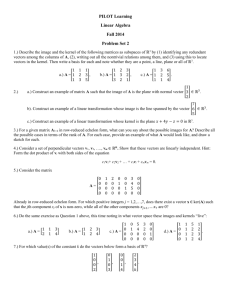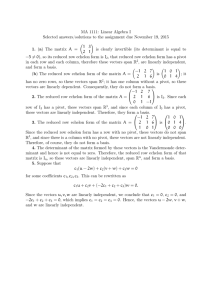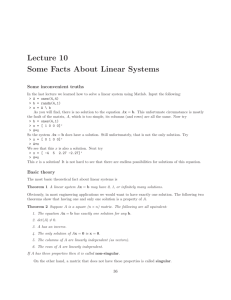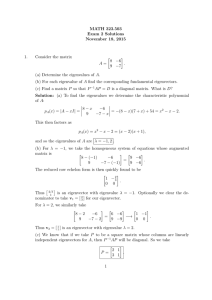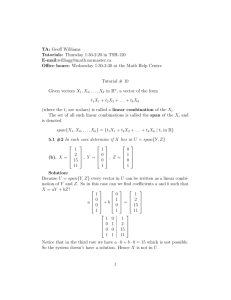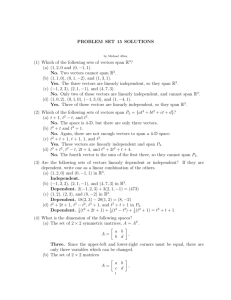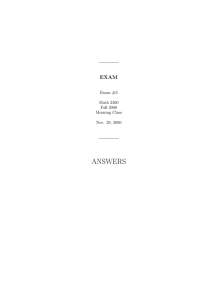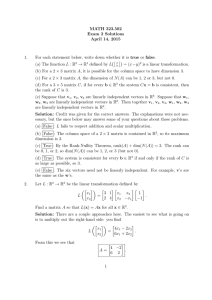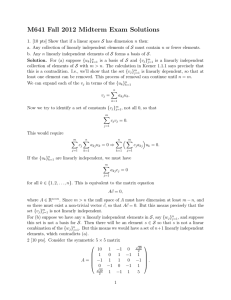MATH 323.501 Exam 2 Solutions November 12, 2013 1.
advertisement
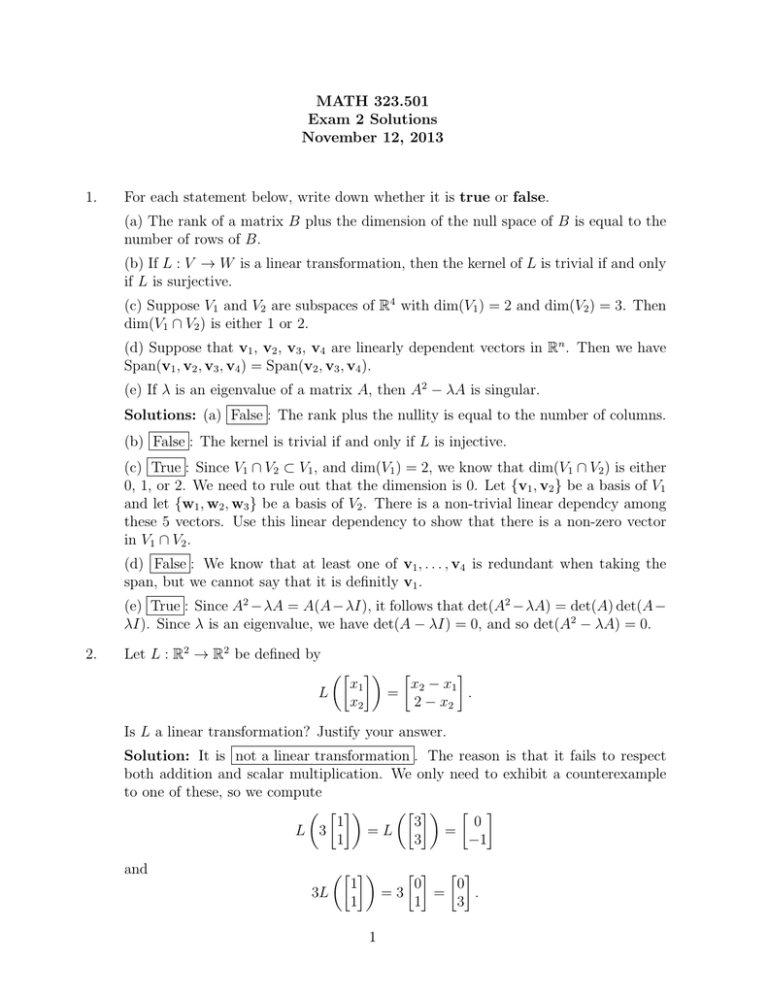
MATH 323.501
Exam 2 Solutions
November 12, 2013
1.
For each statement below, write down whether it is true or false.
(a) The rank of a matrix B plus the dimension of the null space of B is equal to the
number of rows of B.
(b) If L : V → W is a linear transformation, then the kernel of L is trivial if and only
if L is surjective.
(c) Suppose V1 and V2 are subspaces of R4 with dim(V1 ) = 2 and dim(V2 ) = 3. Then
dim(V1 ∩ V2 ) is either 1 or 2.
(d) Suppose that v1 , v2 , v3 , v4 are linearly dependent vectors in Rn . Then we have
Span(v1 , v2 , v3 , v4 ) = Span(v2 , v3 , v4 ).
(e) If λ is an eigenvalue of a matrix A, then A2 − λA is singular.
Solutions: (a) False : The rank plus the nullity is equal to the number of columns.
(b) False : The kernel is trivial if and only if L is injective.
(c) True : Since V1 ∩ V2 ⊂ V1 , and dim(V1 ) = 2, we know that dim(V1 ∩ V2 ) is either
0, 1, or 2. We need to rule out that the dimension is 0. Let {v1 , v2 } be a basis of V1
and let {w1 , w2 , w3 } be a basis of V2 . There is a non-trivial linear dependcy among
these 5 vectors. Use this linear dependency to show that there is a non-zero vector
in V1 ∩ V2 .
(d) False : We know that at least one of v1 , . . . , v4 is redundant when taking the
span, but we cannot say that it is definitly v1 .
(e) True : Since A2 − λA = A(A − λI), it follows that det(A2 − λA) = det(A) det(A −
λI). Since λ is an eigenvalue, we have det(A − λI) = 0, and so det(A2 − λA) = 0.
2.
Let L : R2 → R2 be defined by
x1
x 2 − x1
L
=
.
x2
2 − x2
Is L a linear transformation? Justify your answer.
Solution: It is not a linear transformation . The reason is that it fails to respect
both addition and scalar multiplication. We only need to exhibit a counterexample
to one of these, so we compute
1
3
0
L 3
=L
=
1
3
−1
and
1
0
0
3L
=3
=
.
1
1
3
1
Since these two values are not the same, we see that L does not respect scalar multiplication. Answers may vary of course, and it is also possible to provide a counterexample for addition.
3.
Let A be the matrix
1 1 −2 0
A = 3 5 4 2 ,
0 1 5 1
and let V be the column space of A.
(a) Are the columns of A linearly independent or linearly dependent? Justify your
answer.
(b) Find a basis for V . Show your work.
(c) What is the rank of A? Explain.
Solution: (a) The columns are linearly dependent . The reason is that each column
represents a vector in R3 . Thus we are considering 4 vectors in this 3-dimensional
space, so they must be linearly dependent.
(b) We perform row operations on A
1
0
0
and find that its reduced row echelon form is
1 −2 0
1 5 1 .
0 0 0
The leading 1’s appear in the first two columns, so the first two columns of A will
n o
1
1
3 , 5
make a basis for the column space of A. Thus
is a basis.
0
1
(c) The rank of A is 2 . We know that the rank of a matrix is the same as the
dimension of its column space (or the dimension of its row space, or the number of
non-zero rows when it is put in row echelon form).
4.
1
Let A = {( 11 ) , ( −1
)} ⊆ R2 . We can take it as given that A is a basis for R2 . Suppose
that B is another basis of R2 with change of basis matrix
2 5
P =
.
1 3
That is, for every v ∈ R2 , we have [v]A = P [v]B .
(a) Find a matrix Q such that for every v ∈ R2 , [v]B = Q [v]A .
(b) Suppose that L : R2 → R2 is a linear transformation and that with respect to the
1 −2
B
basis A we have [L]A
A = −3 4 . Find [L]B .
(c) What are the vectors in B with respect to the standard coordinates on R2 ?
Solution: (a) If we take the equation [v]A = P [v]B given and multiply through on
the left by P −1 , we see that P −1 [v]A = [v]B . Thus Q = P −1 , which we calculate as
3 −5
Q = −1
.
2
2
(b) The matrix P is the change of basis matrix from basis B into basis A. Thus
B
P = [I]A
B . Likewise, Q = [I]A . Thus
A
A
[L]BB = [I]BA [L]A
A [I]B = Q [L]A P.
We calculate and find
[L]BB
=
3 −5
1 −2
2 5
10 12
=
.
−1 2
−3 4
1 3
−4 −5
(c) If we let V = [I]SA be the transition matrix from A to the standard basis and let
U = [I]SB be the transition matrix from B to the standard basis, then
A
S
−1
P = [I]A
U.
B = [I]S [I]B = V
Multiplying through by V on the left we see that,
U = V P,
and the columns of U will be the vectors in B with respect to the standard basis. Now
1
V = ( 11 −1
), since those are the coordinates of the basis vectors in A with respect to
the standard coordinates. Therefore,
1 1
2 5
3 8
U=
=
,
1 −1
1 3
1 2
and so with respect to the standard basis B = {( 31 ) , ( 82 )} .
5.
Suppose V is a vector space and that {u, v, w} is a basis for V . Prove that {u + 2v +
3w, 4v + 5w, 6w} is also a basis for V .
Solution: Since {u, v, w} contains 3 elements and is a basis for V , the dimension
of V is 3. Since dim(V ) = 3, any other set of 3 linearly independent vectors in V
will also be a basis. Thus it suffices to show that u + 2v + 3w, 4v + 5w, and 6w are
linearly independent.
Suppose that we have constants a, b, c ∈ R such that
a(u + 2v + 3w) + b(4v + 5w) + c(6w) = 0.
Then by manipulating the left-hand side and gathering terms we have
au + (2a + 4b)v + (3a + 5b + 6c)w = 0.
Since u, v, w are linearly independent, this implies that
a = 0,
2a + 4b = 0,
3a + 5b + 6c = 0.
As a = 0, the second equation implies that b = 0 also. Then using the third equation,
a = b = 0 implies that c = 0. Therefore, u + 2v + 3w, 4v + 5w, and 6w are linearly
independent.
3
6.
Consider the matrix
1 0 −2
A = 2 0 −4 .
−1 0 2
(a) Find the eigenvalues of A.
(b) For each eigenvalue λ of A, find vectors that span the eigenspace corresponding
to λ.
Solution: (a) We calculate
1−λ 0
−2
−λ −4 = (1 − λ)((−λ)(2 − λ) − 2(−λ)) = −λ2 (λ − 3).
det 2
−1
0 2−λ
Therefore the eigenvalues are λ = 0, 3 .
(b) λ = 0: To calculate the eigenspace E0 for λ = 0, we compute the null space of A
itself. The reduced row echelon form of A is
1 0 −2
0 0 0 ,
0 0 0
and so the defining equation of the nullspace is x1 = 2x3 . From this we see that
n o
2
0
0 , 1
E0 = Span
.
1
0
λ = 3: To calculate the eigenspace E3 for λ = 3,
−2 0
2 −3
A − 3I =
−1 0
we compute the null sapce of
−2
−4 ,
−1
whose reduced row echelon form is
1 0 1
0 1 2 .
0 0 0
Thus the defining equations of E3 are x1 = −x3 and x2 = −2x3 , so E3 = Span
4
n −1 o
−2
1
.
